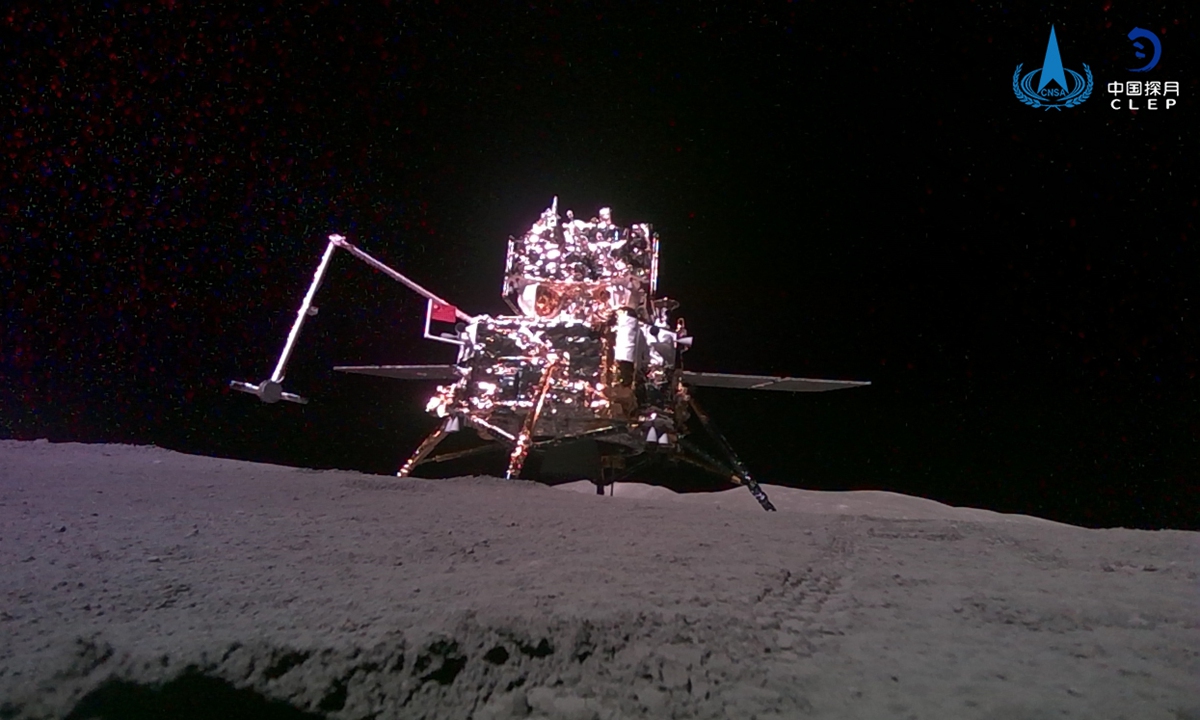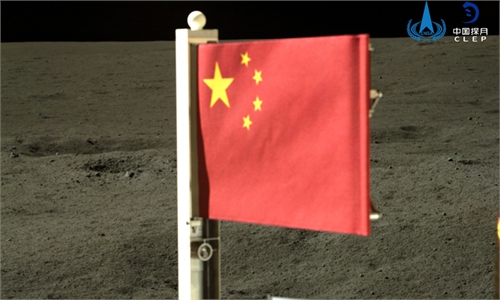
A picture of the Chang’e-6 lunar probe’s lander and ascender vehicles on the surface of far side of moon taken by a mobile camera on June 3, 2024 Photo: Courtesy of the CNSA
The picture of Chang'e-6 lunar probe's lander and ascender on the surface of the far side of moon that was transmitted back to Earth on Tuesday has marked a historic moment of China's space exploration, and became an evident source of national pride. Some netizens left comments that it was such a typical snap just as those you and me would take at every tourist spot and upload to social media, while more were wondering how and who took this picture for the Chang'e-6 on moon.According to the China National Space Administration (CNSA) who released the picture on Tuesday, it was a "mobile camera" that caught the historic moment. And on Wednesday, the China Academy of Spacecraft Technology (CAST) under the state-owned space giant China Aerospace Science and Technology Corporation (CASC,) disclosed that the mobile camera was in fact an autonomous and intelligent micro-robot for moon surface and the academy was the developer for the craft.
The tiny droid is a 5-kilogram-class robot capable of autonomously moving on the lunar surface, Global Times learned from CAST.
During the Chang'e-6 lunar probe mission, this small robot was suspended on the side panel of the lander. After Chang'e-6 completed its lunar sampling, the robot autonomously separated from the lander, moved to a suitable position on the lunar surface, chose the best shooting angle, and optimized the composition to capture a true third-person view image of the lander-ascender combination on the far side of the moon, the academy explained in a statement on Wednesday.
Another mission assigned to the robotic cameraman was to verify autonomous intelligent technology. Autonomous intelligence is the future direction of deep space exploration. With the support of technological innovation projects, CAST has achieved a series of related technological breakthroughs, making this mission a rare opportunity for verification, it said.
When asked how this micro-robot differed from the Yutu lunar rovers, another mobile platform capable of walking on extraterrestrial surfaces, CAST officials explained that in terms of size, the Yutu lunar rover weighs about as much as two adults, while this small robot is much lighter, weighing only about 5 kilograms.
Despite its small size, it is highly functional, with significantly enhanced autonomous intelligence and highly integrated, lightweight hardware. This is the result of collaborative efforts in the field of artificial intelligence by the development team, according to the academy.
CAST developers hailed that the successful lunar sampling by Chang'e-6 marking a groundbreaking achievement in the history of human lunar exploration, adding that the precious images recorded by the micro-robot will become also timeless classics.
More importantly, this innovative practice signifies a solid step toward autonomous intelligence in deep space exploration, promising to have a positive impact on future lunar scientific research, they said.
Carrying valuable rocks and dust collected from the far side of the moon, the ascender of China's Chang'e-6 lunar probe took off from moon surface on Tuesday, and officially embarked on its journey back to Earth, moving toward the goal of returning precious rock and soil from this region to Earth for the first time in history.


